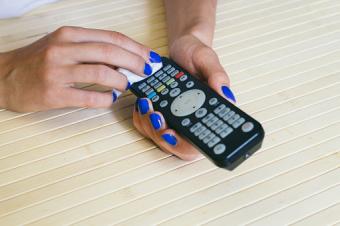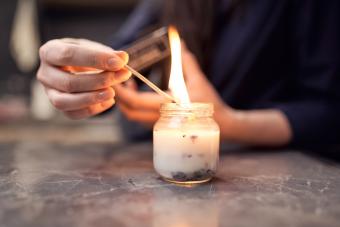
Would it take a scientific study to convince you that your pristine and tidy kitchen may still be dirtier than your teenager's bedroom? Learn the ugly truth about germs and where they accumulate the most. Many exist in plain sight (if you could see them) on surfaces in your home you only thought were clean.
Top 10 Places for Germs and Hidden Dirt
The National Sanitation Foundation, a public health and safety organization, now called NSF International, conducted a study on household germs in 2011. The NSF found the following significant offenders: coliforms that can cause gastrointestinal illnesses, yeast and mold that may cause respiratory problems and skin rashes, and Staphylococcus aureus (staph), a bacteria resistent to antibiotics that can cause a host of health issues.
In addition to the study by the NSF, the following 10 dirtiest places were compiled with the help of expert insight sourced from Better Homes & Gardens (BHG), Real Simple, and the all-natural lifestyle magazine Mother Earth Living. Not all dirt and grime is microscopic; sometimes it just gets overlooked.
Area #1 Kitchen Sponges and Rags
When not cleaned properly themselves, kitchen sponges and rags transfer germs from one location to another rather than removing them. A whopping 86% of kitchen sponges and rags contained yeast and mold, 75% tested positive for coliform bacteria and 18% had staph present. According to Real Simple, the FDA has banned sponges from commercial kitchens, deeming them more hazardous than quick drying rags.

Cleaning tips:
- Michigan State University instructs to sanitize a sponge by placing it wet in the microwave and heating it for a full minute. Be careful removing it as it will be hot.
- Sponges and rags can also be sanitized by running them through the dishwasher on the hottest setting and then use the heated drying option.
- Greenopedia recommends soaking the kitchen sponge overnight in a solution of 2 cups water and a quarter cup of white vinegar. After rinsing, you'll still need to heat the sponge in the microwave if you want to kill any staph bacteria, as vinegar doesn't kill staphylococcus.
Area #2 Kitchen Surfaces
The most disturbing discovery of the NSF study was the high percentage of germs found in the kitchen, even compared with bathrooms. Coliform bacteria was found on:

- 45% of kitchen sinks
- 32% of countertops
- 18% of cutting boards
In comparison, only 5% of toilet seats tested positive for coliform. Yeast and mold were found on 27% of kitchen sinks, (the same percentage found on toilet seats) 18% of kitchen countertops and 14% of cutting boards.
According to BHG, University of Arizona microbiologist Charles P. Gerba claims the kitchen sink is actually dirtier than the toilet after flushing, due to food particles and the moist environment. Cross-contamination is a frequent problem with cutting boards used to trim meat, poultry or fish in addition to ready-to-eat foods such as fruit, vegetables and cheese.
Cleaning tips:
- Keep the sink clean by washing it daily with soap and water and use a disinfecting cleanser once or twice a week.
- Scrub cutting boards with dish detergent and hot water; put plastic boards in the dishwasher. The boards can also be wiped down with undiluted white vinegar.
- Spray countertops down with a solution of equal parts white vinegar and water and wipe with a soft cloth. Do the same for the faucet and handles (if you haven't already wiped them down) on the sink.
Area #3 Knobs, Handles and Switches
Human hands are once again the culprit here, touching and leaving behind dirt and germs on everything including doorknobs, light switches, faucet handles, refrigerator door handle, toilet flush handle, etc. These small items are easily overlooked when cleaning, as most people are much more likely to focus on larger surfaces such as floors, countertops, and furniture. However, in NSF's report, 14% of refrigerator door handles tested positive for staph, while countertops accounted for 0%.

Cleaning tips:
The quickest and easiest way to go through your home and clean and sanitize all of these small items is to grab a container of disinfecting wipes, some rubber gloves and a small plastic grocery bag. Wipe down doorknobs, handles on kitchen appliances, cabinet, drawer and faucet handles, light switches and stove knobs. Repeat in the bathroom and throughout the house. Throw the used wipes in the bag and drop it in the garbage can when you're done.
You can also add 1/4 cup of Pine-Sol to a gallon of warm water and dip a cleaning cloth in it -- no need to rinse after wiping down. This way is slightly more labor intensive but will get the job done.
Area #4 Pet Feeding Bowl, Toys, and Bed
The most beloved members of the family, kids and pets, are also generous contributors of dirt and germs, bringing unwanted substances from the bathroom and outdoors into other areas of the home. According to the NSF study, sources of Coliforms include not washing hands after using the bathroom and pets.
Pet toys were also the highest contributing household item harboring potentially dangerous staph bacteria, which was found on 23% of the toys tested. Pet bowls in 14% of households also had staph present. Real Simple reports that pet beds are also a source of MRSA, pollen, and fecal contamination.
Cleaning tips:
- Hartz.com recommends hand washing with soap and water for plastic and rubber toys, which can also be placed in the dishwasher and run through on the hot cycle with no detergent.
- Rope toys can be wet down and then heated in the microwave for a full minute to kill bacteria, yeast and mold. Otherwise, use the dishwasher method. Stuffed animals can be thrown in the washer and dryer.
- After washing with soap and water, sanitize a feeding or watering bowl by soaking it in a solution of 1 tablespoon of bleach to 1 gallon of water. Rinse with clean water and allow to air dry.
- If the pet bed has a removable cover, take it off once a week and wash in hot water, then tumble dry on high. Otherwise, mist the bed with a sanitizing fabric spray such as Clorox 4 in One Disinfectant and Sanitizer.
Area #5 Bathtub and Shower Curtain
Jackie Harmon of Healthy Clean, a green cleaning company, cautions BHG readers that any lingering standing water remaining in the bathtub after a bath or shower breeds mold, fungi and staph bacteria, which can also thrive on cloth or vinyl shower curtains. Drying off the surface after each use reduces the risk of bacterial growth but not many people are apt to turn around after drying themselves off and use their favorite bath towel to dry out the tub.

Cleaning tips:
- Disinfect a dry bathtub up to three times a week by filling a spray bottle with a solution of at least 3% hydrogen peroxide. Lightly mist the surface and be done as the peroxide will quickly evaporate.
- Spray down vinyl curtains with the same solution or use a mix of equal parts white vinegar and warm water. Wash cloth curtains at least once a month following the label's instructions.
Area #6 Carpets
Real Simple turned to environmental biologist Kelly Reynolds for expert input on the most germ ridden items in the home. Reynolds indicates there could be as many as 200,000 bacteria per square inch in family room carpet, after isolating Salmonella, E. coli, and MRSA in carpet fibers. Carpets trap skin cells, food particles, pollen and pet dander, creating a germ paradise. Walking and other activities done on the carpet brings it all closer to the surface.
Cleaning tips:
Weekly vacuuming with the beater brush turned on helps dislodge dirt and germs from carpet fibers. To help sanitize the surface of the carpet, use an antibacterial spray, such as Lysol Neutra Air Fabric Mist, but test it in an inconspicuous area first. A professional deep steam cleaning is recommended yearly.
Area #7 Toothbrushes, Rinsing Cup and Holder
BHG points out the proximity of toilets to toothbrushes and rinsing cups and then provides the not-so-lovely fact that flushing produces small sprays of fecal debris. Brushing transfers plaque and bacteria from your mouth onto the toothbrush and according to the NSF study, 27% of toothbrush holders tested positive for coliform bacteria.
Cleaning tips:
- Soak rinsing cups and toothbrush holding cups in bleach diluted with water for about 30 minutes. Rinse then soak them in clean water for 30 more minutes to remove the bleach residue.
- Put holders and rinsing cups in the dishwasher if they are dishwasher safe.
- Rinse your tooth brush thoroughly under tap water then shake it out. Allow toothbrushes to dry upright, without the heads touching each other.
Area #8 Washing Machine
Bacteria, mold, and mildew thrive in moist environments and most clothes are washed on warm or cold cycles without the use of bleach. It's easy to overlook an area such as the inside of a washing machine, which one would assume is clean. However, if you've noticed an off smell on clean clothes after they've been laundered, it's probably time to clean the inside of your machine.
Cleaning tips:
Mother Earth Living offers environmentally friendly, non-toxic cleaning solutions such as running a warm cycle with no clothes and adding 5 cups of white vinegar. It is recommended to do this every six months. For a deep cleaning, DIY Natural has a recipe for a white vinegar and baking soda solution with soaking and cleaning instructions to provide a thorough clean.
Area #9 Shared Electronic Devices
Anything touched with the hands frequently and then brought close to the mouth like a phone can pick up and transfer bacteria from both sources. Human hands are actually some of the dirtiest items in a home, especially on kids who are less likely to wash them properly, if at all. Remote controls, cell phones and gaming controls all come into play. Contaminants NSF found on these items include:

- Cell phones - 23% had yeast and mold, 5% tested positive for coliform and staph
- Remote controls - 55% tested positive for yeast and mold, 14% had staph, and 5% showed coliform
- Game controls - 59% showed yeast and mold, 14% contained staph, and 5% carried coliform
Cleaning tips:
Electronic gadgets are very sensitive to moisture so you must use care when cleaning them. Never spray a cleaner directly on the screen, buttons, or keys. Make sure the device is powered off and remove the batteries. Gently wipe it with a pre-moistened disinfecting cloth or spray a disinfecting cleaner on a soft cloth. Use a Q-tip dipped in rubbing alcohol to get in between keys and buttons.
Area #10: Kitchen Cabinet Tops
Maid service owner Derek Christian shared examples of what his staff finds on kitchen cabinet tops with BHG: Years' worth of accumulated dust mixed with items like rodent nests and droppings, dead plant debris, and petrified food -- all hanging out over countertops where food is prepared.
Cleaning tips:
- Something sturdy, like a metal patio chair, small work table, bench, step stool, or stepladder, that can hold the base of a vacuum cleaner with hose attachment makes this cleaning job much easier.
- You can also tackle dirt and debris with a hand-held broom and dust pan but protect your respiratory system with a mouth and nose mask and hands with rubber gloves.
- Finish by wiping down the top with a multi-surface antibacterial cleaner.
Things to Keep in Mind
Don't stress too much on keeping every square inch of your home sanitized -- it's not practical and the body's immune system is designed to handle a fair amount of everyday germs. Mainly focus on the areas where mold and bacteria thrive; moist, warm environments. Frequent hand washing, especially after using the bathroom, and frequent cleaning of food preparation areas can greatly reduce the risk of illness.







